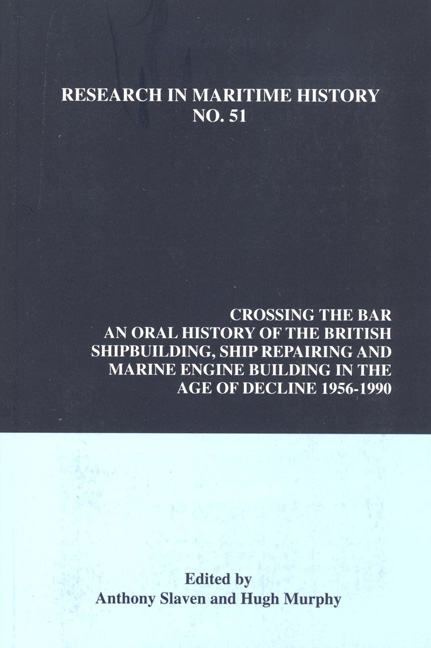 Crossing the Bar
Crossing the Bar from Lower Clyde
I began as an apprentice in the Drawing Office of William Hamilton and Company in Port Glasgow in 1949. After gaining a Higher National Certificate I began my national service in 1955, and then returned to William Hamilton and remained there until they merged with Lithgows in 1960/1. I then moved to the estimating and design departments of Lithgows until 1967, when I became Chief Designer, and in the early 1970s after the merger, I became technical manager, and in 1976, Technical Director. In 1980, I became Technical Director to the Board of Scott Lithgow, but left the firm to join British Shipbuilders after Scott Lithgow became the first British yard to be privatised by the then Conservative Government in March 1984, when it was controversially sold to Trafalgar House pic.
In Lithgows Limited, which I was familiar with from 1960-1969, I would say that the strengths of the company fell into major categories such as good leadership and communications, technical strength, good facilities and investment in those facilities. We had established production processes with well defined functional organisation in the company. We had a good relationship with owners, brokers and ship managers, which helped to provide continuity of work for the same range of ships with the same owners. We had good training facilities for our apprentices. Being a family company, the family spirit was engendered throughout the company structure. We had weaknesses which, within senior and junior management were recognised. There was no real employee relations policy. We did not have a high-powered personnel department. The employee relations were a bit paternalistic, and whenever there were problems there tended to be a buy-out of the problem. Someone would assess the value and decide that the best solution was to buy the guys off. There was a poor graduate intake into production areas. Most of the graduates who joined the company tended to find themselves in the technical department. Perhaps, because of the family atmosphere, people were slow to accept changes, particularly in respect of management style and production processes. That may have been because of the age profile of the management, but, at least in the technical department, there tended to a younger age profile.
To save this book to your Kindle, first ensure [email protected] is added to your Approved Personal Document E-mail List under your Personal Document Settings on the Manage Your Content and Devices page of your Amazon account. Then enter the ‘name’ part of your Kindle email address below. Find out more about saving to your Kindle.
Note you can select to save to either the @free.kindle.com or @kindle.com variations. ‘@free.kindle.com’ emails are free but can only be saved to your device when it is connected to wi-fi. ‘@kindle.com’ emails can be delivered even when you are not connected to wi-fi, but note that service fees apply.
Find out more about the Kindle Personal Document Service.
To save content items to your account, please confirm that you agree to abide by our usage policies. If this is the first time you use this feature, you will be asked to authorise Cambridge Core to connect with your account. Find out more about saving content to Dropbox.
To save content items to your account, please confirm that you agree to abide by our usage policies. If this is the first time you use this feature, you will be asked to authorise Cambridge Core to connect with your account. Find out more about saving content to Google Drive.